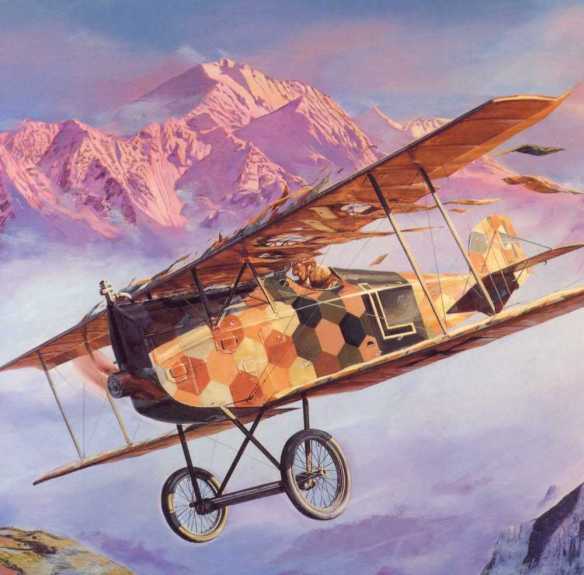
In many respects, the D.I was a good combat aircraft. It was reasonably fast, had excellent flying characteristics and maneuverability, and could reach higher altitudes than most of its adversaries. In addition, it was provided with a roomy and comfortable cockpit which gave a good field of view.
Despite those desirable features, the new Aviatik fighter wasn’t greeted with enthusiasm when it entered service in autumn 1917, as the type also had some serious defects which didn’t endear it to its pilots. The early aircraft had structural deficiencies and their machine guns were installed beyond the reach of the pilot; if the gun(s) jammed, there was nothing he could do about it. These problems were later rectified with the strengthening of the airframe and the repositioning of the guns, but the main cause of complaints was the engine’s tendency to overheat far too easily. To alleviate the cooling problems, operational units tended to fly their aircraft without the engine’s top panels and sometimes also the side panels were left off.
The Austro-Hungarian aviation units used the D.I widely until the end of World War I on Eastern, Italian and Balkan fronts, mainly as an escort fighter for the 2-seater reconnaissance aircraft, as the most fighter units preferred the Albatros D.III in air superiority role.
A major power in the early use of air warfare. Aviation roots ran deep in the Austro-Hungarian Empire, which undertook the world’s first aerial attack in 1849: two unmanned balloons, laden with explosives, launched and aimed at the Italian arsenal in Venice.
Following this promising beginning, however, progress slowed, and by the time World War I erupted the Dual Monarchy could only lay claim to a single aircraft builder, Lohner. Lacking the industrial capacity of Germany, Austro-Hungary’s aviation did not develop as rapidly prior to, or during, the war. A good comparison can be seen in the prewar investment of the two powers: Austria-Hungary spent the equivalent of $318,307 on military aviation in 1914,whereas German investment that same year was $14,836,726.Despite the inauspicious start, however, Austro-Hungarian achievements were impressive.
During the war, the aircraft industry expanded to the point that, at the Armistice, another nine companies had joined Lohner in the aircraft field. It should be pointed out, however, that many of these firms, such as the Ostdeutsch Albatros Werke (East German Albatros Work),were branches of German aviation companies set up in the Habsburg Empire to assure that the wartime military needs of Germany’s ally were met, as well as to exploit the possibilities of the Austro-Hungarian market. The number of workers engaged in aviation production had grown steadily as well, from 1,400 in 1914 to 12,000 in October 1918.Those 12,000 workers had managed to produce a respectable 4,768 aircraft for the army and another 413 for the navy, as well as 4,900 engines. The design departments were also busy, cranking out some 125 different prototypes, as well as two tethered helicopter designs intended to replace observation balloons.
Many names with bright futures came out of the Austro-Hungarian design offices of World War I, including Ernest Mach, Ferdinand Porsche, and Igo Etrich, among others.
Wartime command of the Austro-Hungarian Luftfahrtruppe (Aviation Troops) fell to the very capable Oberst (Colonel) Emil Uzelac, a post held by generals in the other European air forces. Uzelac was highly regarded by his superiors as well as the troops under his command and was noted for regularly seeking out the advice and opinions of the lower ranks when inspecting aviation fields. Both a pilot and an engineer, as well as being organizationally gifted, Uzelac was able to mold the Luftfahrtruppe into a highly effective fighting force that soldiered on right up to the end of the empire.
Austria-Hungary, like its German ally, was forced to fight on two fronts: Russia to the north and Italy to the south. Its position was complicated even further by the diverse and stratified society that populated the Dual Monarchy, where 14 different languages were spoken. Although the language of command was uniformly understood, its vocabulary was limited to approximately 200 words. This forced the burden of day-to-day management onto local noncommissioned officers (NCOs) who were able to communicate with the troops. Yet despite the heavy reliance placed on its NCO force, the stiffly structured social tradition of the Austro- Hungarian military denied these men promotion to the officer corps. In Germany, a talented and successful NCO pilot might expect a promotion to the commissioned ranks, but this never happened in the Austro-Hungarian military. Of the 49 Luftfahrtruppe pilots who achieved ace status during the war, 19 were NCOs. Only one of those 19, Josef Kiss, whose 19 victories placed him fifth on the aces’ list, was promoted to Leutnant (second lieutenant), and that honor was achieved only posthumously.
Aircraft and airmen operating in Austria-Hungary had to be rugged to withstand the rigors of the mountainous terrain over which the aerial battles were fought. Oftentimes, a forced landing was deadlier than an opposing airman. Naval operations were equally hazardous, with regular trips in frail-looking Lohner flying boats from the naval air station at Pola across the Adriatic and back to and from that favorite target, Venice. In the end it all came to nothing. Like its German counterpart, the Luftfahrtruppe did not survive the Armistice. With the collapse of the Habsburg Empire and the end of the war, Austria-Hungary was obliged to dismantle its air force. Under the supervision of the Inter-Allied Control Commission, the remnants of the Austro-Hungarian aviation accomplishment were reduced to cinders.
References Grosz, Peter M., George Haddow, and Peter Schiemer. Austro- Hungarian Army Aircraft of World War One. Mountain View, CA: Flying Machines Press, 1993. O’Connor, Dr.Martin. Air Aces of the Austro-Hungarian Empire, 1914–1918. Mesa, AZ: Champlin Fighter Museum Press, 1986.